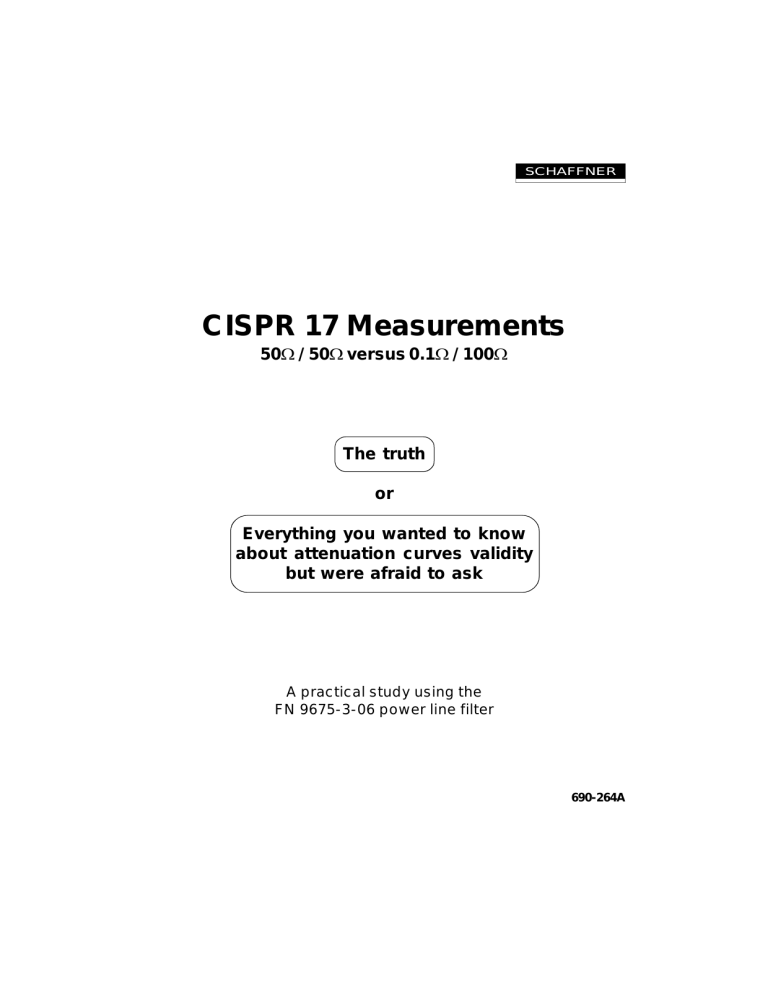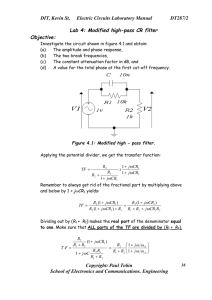
SCHAFFNER CISPR 17 Measurements 50Ω / 50Ω versus 0.1Ω / 100Ω The truth or Everything you wanted to know about attenuation curves validity but were afraid to ask A practical study using the FN 9675-3-06 power line filter 690-264A SCHAFFNER CISPR 17 Measurements Schaffner EMV AG CH-4542 Luterbach/Switzerland SCHAFFNER 1 Introduction The use of power line filter insertion loss/attenuation curve data (as published by filter manufacturers) has been a frustrating experience to less experienced EMC engineers for a very long time. Engineers with extensive experience in EMC consider these curves, generally prepared from data taken in a 50Ω test setup, to be of extremely limited value. In spite of this, filter manufacturers continue to publish 50Ω data, since popular 50Ω equipment, connectors and test cables make these the most easily taken measurements. Attenuation curves using 50Ω impedance are severely criticized in many books and technical papers as well as in insertion loss measurement standards such as Mil Std 220A and CISPR 17. CISPR 17 gives several alternatives to 50Ω insertion loss measurment curves. These alternatives are aimed at showing the filter effectiveness in real situations rather than in an artificial situation. The cause of the problem is that in real life situations, a power line filter is not terminated with 50Ω impedances. In fact, the filter termination is usually an unknown value that often changes with frequency. Since the filter performance is largely dependent upon termination impedance, the curves given in 50Ω can never represent the real live situation. 2 Alternatives to 50Ω measurement One of the alternatives given in CISPR 17 is the so called "Approximate Worst Case Method". In this test method the filter insertion loss is measured with 0.1Ω and 100Ω terminations on the line and load side, respectively. The measurements are then repeated with the terminating impedances reversed. Fig. 1 2 "Approximate Worst Case" test diagram SCHAFFNER Although this test method is not the same as measuring a filter in a real equipment installation, the normalized results can be used with relative accuracy to predict the performance of the filter in a real situation. Another advantage is that it is a well defined standard measuring method from CISPR. This test yields accurate and repeatable results. The power line filter industry must publish data on its products using recognised, standardized and accepted test methods. If, as generally accepted, the 50Ω method cannot be used to predict the performance of a filter in real equipment, the CISPR 17 "Approximate Worst Case" method is the only such standardized test to meet this requirement. 3 How to use 0.1Ω / 100Ω data SCHAFFNER has conducted tests on many different interference sources in real equipment with and without a filter. A statistical analysis of the results of noise measurements with and without the filter gives the "Effective Attenuation" of that filter. Unfortunately, a filter customer is rarely able to make such complex measurements and must normally rely on predictions from published data. When this "Effective Attenuation" data is compared to attenuation curves taken using the 50Ω/50Ω and the 0.1Ω/100Ω methods, the latter is clearly seen to more nearly portray the real performance of the filter. The 50Ω/50Ω attenuation curve will consistently show higher levels of performance than actually achieved, sometimes by significant amounts. The 0.1Ω/100Ω attenuation is normally slightly less than the real "Effective Attenuation", although often by only a few dB. Fig. 2 below shows the results for a SCHAFFNER FN 9675-3 line filter. Curve A Effective system attenuation Curve B 0.1Ω/100Ω attenuation measurement Curve C 100Ω/0.1Ω attenuation measurement Curve D 50Ω/50Ω attenuation measurement Fig. 2 FN 9675-3 differential mode data 3 SCHAFFNER In Fig. 2 the data cover the lower frequency range up to 1MHz. The data presented for the 50Ω/50Ω and 0.1Ω/100Ω methods are those measured in the differential or "symmetrical" mode. In this frequency range the "Effective Attenuation" as measured corresponds closely to the symmetrical attenuation curve. Above 1MHz, the common mode or "asymmetrical" mode attenuation is found to be more important. In some cases common mode attenuation data is also useful at lower frequencies. Curve A Effective system attenuation Curve B 0.1Ω/100Ω attenuation measurement Curve C 100Ω/0.1Ω attenuation measurement Curve D 50Ω/50Ω attenuation measurement Fig. 3 FN 9675-3 common mode data Fig. 3 shows that in this higher frequency range the "Effective Attenuation" corresponds closely to the common mode or "asymmetrical" curve. Of course, in an actual analysis of a real customer's product, if it is possible to determine if the system under test has a low or a high input impedance, a choice can be made between the 0.1Ω/100Ω curve and the 100Ω/0.1Ω curve for even better correllation. Obviously, at frequencies above a few MHz, normal EMC practices are required to insure optimum filter performance. This includes a reduction of all coupling paths across the filter. The proper application of bonding, grounding, cable routing and filter positioning techniques will optimize filter performance. Fig. 2 shows the differential mode with a negative insertion loss, that is an insertion gain! This happens relatively often in practice. It would be unwise to try to use such a filter in an equipment with a discrete interference frequency falling within this region, but only 0.1Ω/100Ω attenuation data will help a designer spot this problem beforehand. In the common mode data of Fig. 3 the 0.1Ω/100Ω curve is very different from the 100Ω/ 0.1Ω curve. This kind of difference can also exist in the differential mode, depending on the actual configuration of the filter. 4 SCHAFFNER The common mode curve C shows a dip in the insertion loss at 6MHz. A similar resonance was seen during testing in our lab when a filter was mounted in the equipment "the wrong way", with the Y caps on the line side. This may explain why Y caps are usually placed on the load side of a filter. But the 0.1Ω/100Ω curves allow you to see that a potential problem exists that you would not have seen with 50Ω data. 4 Saturation current The 0.1Ω/100Ω curves shown above are taken without load. The change in inductance with load current is shown separately. This is another simple and repeatable test. We recommend that the line current wave shape of the equipment under test be measured using an oscilloscope and current probe before the filter is installed. The most important measurement is that of the peak current the filter must sustain. Relating this peak current to the saturation curve of the filter will show what percentage of the inductance remains at that current. If there is little change in the inductance at that peak current, you can use the 0.1Ω/100Ω curves as they are. If the inductance falls by up to 50%, then you need to allow for a variation of up to 6dB in the attenuation given in the 0.1Ω/100Ω curves. We recommend that you consider another filter if the inductance falls by more than 50%. Fig. 4 Saturation curve Filters from SCHAFFNER are designed for stable inductance over the normal ranges of peak to RMS current ratios found in today's capacitor input power supply circuits. 5 SCHAFFNER 5 An example Fig. 5 shows an EMI test curve of the noise output of a typical switched-mode power supply (SMPS). The noise limits of the VDE specification are also shown. Using an oscilloscope, the line current was measured to have a peak value of 3.5A, which compares to the 1.1A measured with an RMS-reading meter. This peak to RMS ratio (or "Crest Factor") of 3.2:1 is typical for a SMPS, and much higher than the 1.4:1 ratio obtained on a resistive load. Inrush current (on startup) was greater than 15A. Fig. 5 Noise output of a typical SMPS In this example we would like to use the FN 9675-3-06, a high performace filter rated for a maximum RMS line current of 0.3A. The saturation curves for this filter is shown in Fig. 6. At the peak current of 3.5A there is still more than 95% of the inductance present. The 0.1Ω/100Ω curve for this filter is shown in Fig. 2 and Fig. 3. 6 SCHAFFNER Fig. 6 Saturation curve for a FN 9675-3-06 Using the symmetrical attenuation (differential mode) data for less than 1MHz and the asymmetrical attenuation (common mode) data for above 1MHz, a prediction of the noise output of the equipment with the filter can be made. Curve A Curve B Curve C Noise level prediction with 50Ω curves Noise level prediction with 0.1Ω/100Ω curves Real system noise level after filtering The result is shown in Fig. 7, together with an actual noise test taken with the filter in the equipment. In the region below 10MHz the prediction corresponds almost exactly to the actual results. Fig. 7 Noise level prediction vs. results 7 SCHAFFNER In general, the actual system noise after filtering is usually found to be below the system noise level prediction using the 0.1Ω/100Ω method. At frequencies above 10MHz, coupling effects can bypass the filter and give an unrealistic shape to the attenuation curves. Also shown is a system prediction based on 50Ω test curves. At low frequencies, which is a very critical region in this application, these show a deviation of up to 20dB from the actual results. Had we based the filter selection on 50Ω curves, a smaller, cheaper and ineffective filter would have appeared sufficient. This would have lead to time wasted on the unnecessary evaluation of the "wrong" filter, or to a system design that failed qualification testing. 8 SCHAFFNER Corporate Headquarters Schaffner EMV AG Nordstrasse 11 CH-4542 Luterbach/Switzerland Phone +41 32 6816 626 Fax +41 32 6816 641 Subsidiary companies China Schaffner Beijing Liaison Office Phone +86 10 6510 1761 Fax +86 10 6510 1763 Finland Schaffner Electro Ferrum Oy Phone +358 19 326 616 Fax +358 19 326 610 France Schaffner EMC S.A.S. Phone +33 1 34 34 30 60 Fax +33 1 39 47 02 28 Germany Schaffner EMV GmbH Phone +49 721 569 10 Fax +49 721 569 110 Italy Schaffner EMC S.r.l. Phone +49 02 66 04 30 45 Fax +49 02 61 23 943 Japan Schaffner EMC K.K. Phone +81 3 3418 5822 Fax +81 3 3418 3013 Singapore Schaffner EMC Pte. Ltd. Phone +65 6377 3283 Fax +65 6377 3281 Sweden Schaffner EMC AB Phone +46 8 5792 1121 Fax +46 8 92 96 90 Switzerland Schaffner EMV AG Phone +41 32 6816 626 Fax +41 32 6816 641 United Kingdom Schaffner EMC Ltd. Phone +44 118 977 00 70 Fax +44 118 979 29 69 USA Schaffner EMC Inc. Phone +1 732 225 9533 Fax +1 732 225 4789 Albrecht/March 1996
